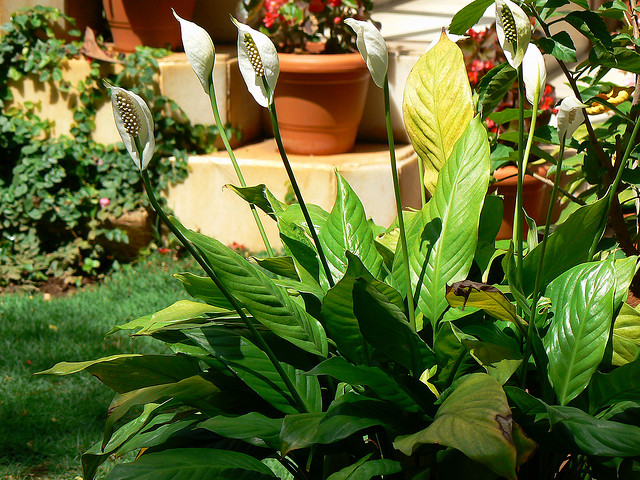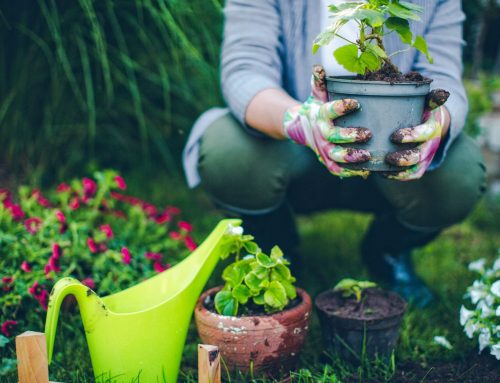Every year when gardening season rolls around, all of the eco-friendly blogs, websites and destinations out there begin to publish their annual gardening articles. We’re no different here at Postconsumers as we clearly believe that the more you grow – the less you buy! But this year, we wanted to be more conscious of the fact that not everybody has access to an outdoor garden. In fact, the majority of the American population lives in urban centers. That doesn’t mean that you can’t benefit from green plants though! There are plenty of houseplants that can make your environment more eco-sound (as well as simply more energized and pleasant). Today, we’re running down the list of the top ten houseplants that can actually also improve the air quality in your home. And if you live urban, then you know that it’s always about the air quality!
Believe it or not, this list was constructed by NASA. As a response to the growing (and real) epidemic of “sick building syndrome”, NASA (for reasons we’re unsure of) conducted a study of houseplants and how effective they were at filtering out hazardous chemicals from the air. The result of the study is the list below. Not only can these plants help to purify your home air, they can also help to regulate humidity. AND you’re not adding to the consumption cycle of buying an air purifying machine or dehumidifier.
1. Areca palm (Chrysalidocarpus lutescens)
You get a double benefit with the areca palm. Not only was it the most effective plant tested at removing toxins from the air, but it also actively releases moisture into the air. If you suffered through a dry winter this year, you know how important that can be. Areca palm can also help to remove salt from soil (if that’s an issue with you). The areca palm does best in semi-sun with a temperature of between 65-75 degrees. It’s easy to take care of and very resistant to pests (ie: you do not need a green thumb).
2. Lady palm (Rhapsis excelsa)
Lady palms are resistant to pests and grow slowly (which is important if you’re an apartment-dweller). They do best in 60-70 degree temperatures with semi-sun. However, in the winter the plant can’t go below fifty degrees, so if you keep your place chill in the winter months, this is not the plant companion for you.
3. Bamboo palm (Chamaedorea seifrizii)
Note: the bamboo palm can grow up to six feet tall, so this is not the air purifying plant for you if you live in a tiny urban studio and move often. It is, however, extremely resistant to pests and more effective at air purification than that lady palm. If you do have room for an indoor tree, keep this one between 60 and 75 degrees and, again, not less than 50 degrees in a semi-sunny environment.
4. Rubber plant (Ficus robusta, shown above)
No, you are not making rubber with this plant. It got its name because of the appearance of its leaves. It also requires very little light and can survive in low temperatures (ie: it’s perfect for a man-cave). It’s been shown to be extremely effective at removing formaldehyde from the air, but be wary. It can grow to up to eight feet tall. Put it in semi-shade to semi-sun. It likes it at 60-80 degrees but can tolerate temperatures as low as 40 degrees.
5. Dracaena “Janet Craig” (Dracaena deremensis “Janet Craig”)
This plant is great for your home office as it’s proven to be effective at removing trichloroethylene from the air, which is a chemical that’s often emitted by photocopiers and scanners. Be careful – you want to buy the “compacta” variety of this plant which grows to between one and three feet. The full version can grow as high as ten feet. This plant does best in semi-shade as well as poorly lit areas and temperatures between 60 and 75 degrees.
6. English ivy (Hedera helix)
Another plant that’s been proven to be great at removing formaldehyde from the air, English ivy is also beautiful to look at. It grows best from hanging baskets in semi-sun or semi-shade with temperatures ranging from 50 to 70 degrees.
7. Dwarf date palm (Phoenix roebelenii)
While dwarf date palms can reach a height of six feet, they grow slowly and do well without much light. They can also survive for decades. This is our way of saying that they are durable and are great if you’re not good with plants. Date palms are super for removing xylene from the air, which is a chemical emitted by caulking, adhesives, floor covering, wall coverings, paints and particle boards. Keep it above 50 degrees and it does all the work for you.
8. Ficus alii (Ficus macleilandii)
Can’t decide what you want your plant to look like? Luckily, ficus alii comes in three varieties: a single plant, a full bush (multiple stems in one pot) or braided (multiple stems intertwined). The best temperatures range from 55 degrees to 75 degrees. Don’t worry if your ficus alii molts at first – sometimes it takes them a while to get used to a new environment.
9. Boston fern (Nephrolepis exaltata “Bostoniensis,” shown above)
Lush foliage but no flower – if that’s your personality then this plant expresses it perfectly. While the Boston fern is effective at removing airborne chemicals and humidifying the air, it requires more TLC than the other plants we’ve mentioned. Boston ferns thrive when grown on a pedestal or in a hanging basket. They need to be misted regularly though, and their temperature range is a somewhat narrow 50 to 75 degrees.
10. Peace lily (Spathiphyllum sp.)
If you want a flower rather than a plant, the white, shell-like flowers of the peace lily are similar to those of the calla lily. As flowers go, it’s relatively easy to take care of, but like all flowers it won’t be as durable as a non-flowering plant.
Did we miss an air-purifying plant that you really, really feel that we should have shared? Tell us about it on the social media channels below.
Facebook | Twitter | Instagram | Tumblr | Pinterest | Google+
Related Information
Best Medicinal Plants for Your Bathroom
Best Plants to Give as Holiday Gifts
Photo Credit: Dinesh Valke via Flickr





